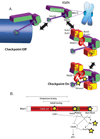Linking kinetochore-microtubule binding to the spindle checkpoint
- PMID: 18410725
- PMCID: PMC2696048
- DOI: 10.1016/j.devcel.2008.03.015
Linking kinetochore-microtubule binding to the spindle checkpoint
Abstract
The spindle checkpoint blocks cell-cycle progression until chromosomes are properly attached to the mitotic spindle. Popular models propose that checkpoint proteins associate with kinetochores to produce a "wait anaphase" signal that inhibits anaphase. Recent data suggest that a two-state switch results from using the same kinetochore proteins to bind microtubules and checkpoint proteins. At least eight protein kinases are implicated in spindle checkpoint signaling, arguing that a traditional signal transduction cascade is integral to spindle checkpoint signaling.
Figures



References
-
- Basto R, Gomes R, Karess RE. Rough deal and Zw10 are required for the metaphase checkpoint in Drosophila. Nature Cell Biology. 2000;2:939–943. - PubMed
-
- Baumann C, Korner R, Hofmann K, Nigg EA. PICH, a centromere-associated SNF2 family ATPase, is regulated by Plk1 and required for the spindle checkpoint. Cell. 2007;128:101–114. - PubMed
-
- Brady DM, Hardwick KG. Complex formation between Mad1p, Bub1p and Bub3p is crucial for spindle checkpoint function. Curr. Biol. 2000;10:675–678. - PubMed
-
- Chan GK, Jablonski SA, Starr DA, Goldberg ML, Yen TJ. Human Zw10 and ROD are mitotic checkpoint proteins that bind to kinetochores. Nat Cell Biol. 2000;2:944–947. - PubMed
Publication types
MeSH terms
Substances
Grants and funding
LinkOut - more resources
Full Text Sources

